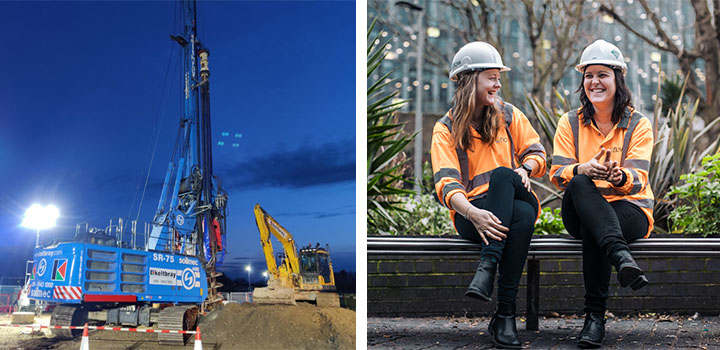UEA submits its Earthshot environmental solutions
By: Communications

It’s the global award that encourages innovative resolutions to the climate crisis, and UEA has formally submitted two solutions from the construction industry to attempt to win the £1m prize funding from The Earthshot Prize.
UEA asked its staff and students in January to submit their entries for the Earthshot Prize, the scheme offering £1m in funding to five climate crisis solutions worldwide every year. The prize is in its second year and is championed by Sir David Attenborough and the Duke and Duchess of Cambridge.
Last year’s award was hotly contested, with UEA one of over 100 Official Nominators across the globe, who in total put forward 750 nominations.
These were then whittled down to 15 through an independent assessment, with the Prize Council then choosing the five winners who receive the £1m funding prize.
The 2022 Earthshot Prize is likely to generate even more nominations, with the number of nominators expanding to 345 across 80 countries.
The two UEA nominees approached the University as an Official Nominator and have since been put forward by UEA to get to this stage. Here’s the lowdown on HIPER® Pile and QFlow:
Name: HIPER® Pile
Who has nominated: Kiro Tamer (Head of Environmental Sustainability at construction company Keltbray)
What’s the problem: The concept was driven by frustrations and safety implications related to the way that ordinary piles (which are used to carry vertical loads in construction) are installed. Ordinary pile foundations create unnecessary waste and, as they cannot be inspected, at the end of the building’s life there is no way for them to be reused.
What’s the solution being proposed: The HIPER® Pile redefines deep foundations as low carbon, sustainable and reusable assets.
This unique characteristic makes it better than other pile foundation designs and solutions. It significantly reduces the material required in the first place, it is reusable and the foundation void can also be used as a source of energy, and this sets it apart from anything else available.
The HIPER® Pile will also play a vital part in supporting future micro energy grid which will play a key part in decarbonisation from a central fossil fuel-based power and heating grid.
What will they do with the prize money: To share with the construction industries all across the globe the engineering techniques and tools required in order to implement the HIPER® pile in order for everyone to significantly demand less concrete and in order to benefit from free heat from the ground.
What did the judges say: “As our cities continue to expand and develop, HIPER® Pile provides a sophisticated solution to growing demand for sustainable construction”; Konstantinos Chalvatzis; Professor of Sustainable Energy Business, NBS
Name of solution: QFlow
Who has nominated: Ms Brittany Harris (QFlow Co-founder and CEO)
What’s the problem: The construction industry consumes 40% of the world’s raw resources and is responsible for 40% of global carbon emissions. Shockingly, 13% of all those materials delivered to site go direct to waste without being used.
What’s the solution being proposed: QFlow is changing this. With improved tracking and management of materials coming onto site and waste leaving, it is ensured that construction and development teams use only the right materials in their projects; reducing waste, saving time and money spent correcting errors, and delivering more responsible, sustainable construction for all.
QFlow puts the construction industry’s unique needs first. They identified and unpicked a specific and massive problem for the industry, and then identified the technology to solve it. Using a combination of machine learning and human support, their customers were able to get the value and outcomes they needed, without the pain of adopting complex technology in an under digitised industry, leading to Qflow having a 100% client retention rate.
What will they do with the prize money: QFlow’s aim is to expand their reach beyond the UK market and connect with other innovators to tackle sustainability in construction. However, they are aware that they cannot do this alone, and must find ways to collaborate with others in this space. With further reach and more data, their aim is to develop Qflow to support reuse and refurbishment marketplaces to fuel the circular economy in construction. Qflow could be the missing piece that helps them reach a critical mass, and further reduce material consumption and waste in one of the world’s most pollutive industries.
What did the judges say: “A very simple and elegant solution to a market sector that is notoriously ungreen”; Laura Bowater; Professor of Microbiology Education and Engagement, MED
For more information on ClimateUEA, check out their page on the UEA website.
Related Articles

Nurses worldwide rely on intuition to triage patients
Nurses around the world use intuition to work out how sick a patient is before triaging for treatment according to new research from the University of East Anglia.
Read more
UEA nursing apprentice’s sky-high dive for Alzheimer's and Dementia awareness
On Sunday 24 September, University of East Anglia (UEA) nursing apprentice Francessca Turrell will be taking part in a charity skydive for Alzheimers Society, a UK care and research charity for people with dementia and their carers.
Read more
New book to focus on Norwich’s medieval logos
Logo Rewind: Trademarks of Medieval Norwich is a new book from UEA Publishing Project, in collaboration with CreativeUEA and featuring the work of Darren Leader, which will focus on the stories of Norwichs medieval merchants marks found in different locat
Read more